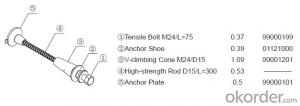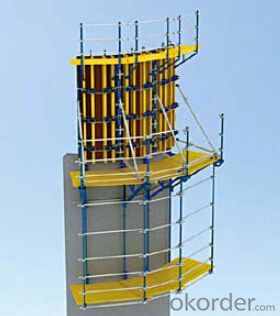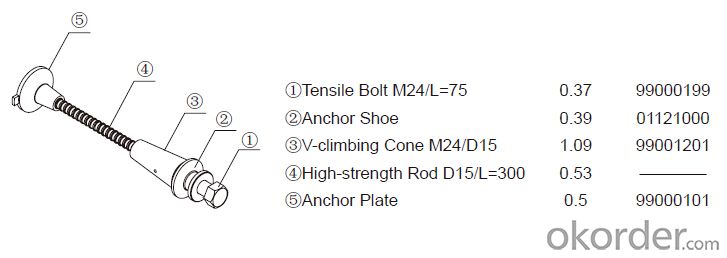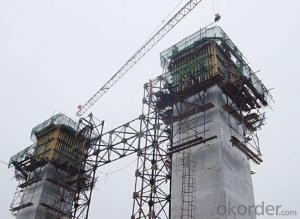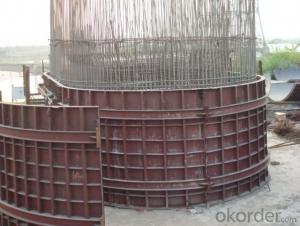Climbing-Platform CP190 for Formwork and Scaffolding system
- Loading Port:
- Tianjin
- Payment Terms:
- TT OR LC
- Min Order Qty:
- 50 m²
- Supply Capability:
- 1000 m²/month
OKorder Service Pledge
OKorder Financial Service
You Might Also Like
Climbing Platform CP190
Climbing bracket CP190 is mainly used as operating platform during construction. It can be used
on the vertical wall and arced wall. The bracket hang on the anchor system and all the load are
supported by anchor system. It’s convenient to assemble and dismantle, the construction is easy,
rapid and safe.
Anchor System:
Anchor system is the most important supporting part. The system is made of five parts shown
below. There into, tensile bolt, anchor shoe and V-climbing cone can be taken out for reusing.
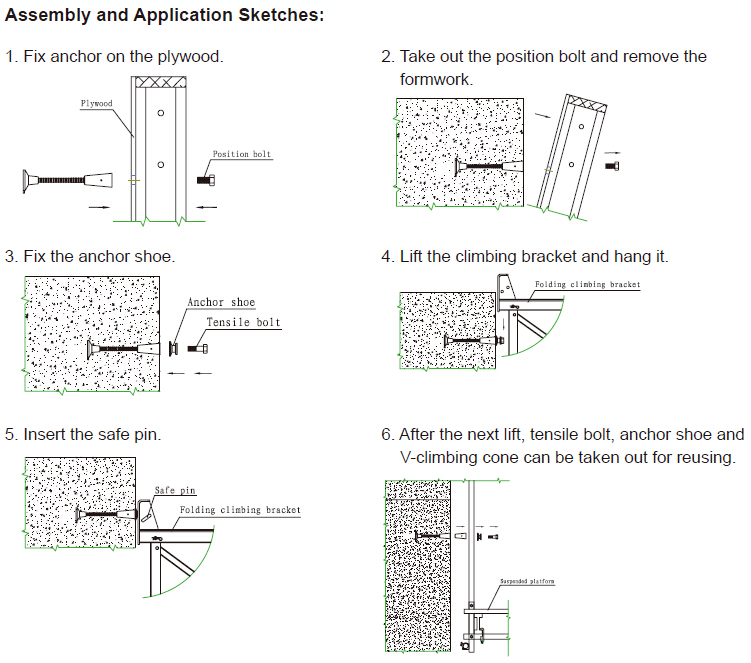
- Q: How does steel formwork handle different concrete pouring techniques?
- Steel formwork is highly versatile and can handle various concrete pouring techniques with ease. Its sturdy structure and durability enable it to withstand the pressure and weight of different concrete pouring methods, such as pouring by hand, pouring with a pump, or pouring using a crane. The steel formwork provides excellent support and stability, ensuring that the concrete maintains its desired shape and structure during the pouring process. Additionally, steel formwork can be easily adjusted and customized to accommodate different pouring techniques, making it a preferred choice for construction projects that require flexibility and adaptability.
- Q: How does steel formwork affect the overall safety of construction workers?
- Construction workers can greatly improve their safety by using steel formwork. The durability and strength of steel formwork make it highly resistant to damage or collapse during construction, protecting workers from potential accidents. Furthermore, steel formwork is designed to be structurally stable, providing a secure platform for workers to carry out their tasks. This stability reduces the risk of slips, trips, and falls, which are common accidents in construction sites. With a stable formwork system, workers can confidently work at heights without fear of the platform giving way. In addition, steel formwork is modular and easily assembled, allowing for quick and efficient construction processes. This reduces workers' exposure to potential hazards and risks, as they spend less time on the construction site. By shortening the project duration, steel formwork also reduces workers' fatigue and stress levels, leading to increased alertness and improved safety. Another safety advantage of steel formwork is its resistance to fire. Steel does not burn or contribute to the spread of fire, providing an extra layer of protection for construction workers in case of fire accidents on-site. This significantly reduces the risk of injuries or fatalities due to fire incidents, ensuring worker safety. Overall, the use of steel formwork in construction significantly enhances worker safety. Its durability, stability, quick assembly, and fire resistance properties all contribute to creating a safer working environment, reducing the likelihood of accidents and injuries. By investing in steel formwork, construction companies prioritize worker well-being and promote a culture of safety on the construction site.
- Q: Can steel formwork be used in sports facility construction projects?
- Sports facility construction projects can utilize steel formwork, a versatile and durable option that presents several advantages. First and foremost, it boasts exceptional strength and stability, rendering it suitable for large-scale structures such as sports facilities. Steel formwork is capable of withstanding heavy loads and pressures, thereby guaranteeing the construction's integrity and safety. Furthermore, steel formwork is highly reusable, leading to significant reductions in construction costs and waste. It can be effortlessly disassembled, cleaned, and reassembled for future projects, making it an environmentally friendly choice for sports facility construction. Additionally, steel formwork permits precise and accurate construction. Its rigidity and dimensional stability guarantee the attainment of the desired shape and dimensions for the sports facility. This is especially crucial in sports facilities where precise measurements and uniformity are paramount for proper functionality. Moreover, steel formwork provides a smooth and uniform surface finish. This attribute is indispensable in sports facilities where the playing surface must be even and consistent to ensure fair gameplay and prevent injuries. To summarize, steel formwork is a suitable option for sports facility construction projects due to its strength, reusability, precision, and smooth surface finish. It offers numerous benefits and can contribute to the successful completion of sports facilities.
- Q: Can steel formwork be used for projects with limited formwork stripping time?
- Yes, steel formwork can be used for projects with limited formwork stripping time. Steel formwork is known for its durability and strength, making it suitable for various construction projects. Unlike traditional formwork materials such as wood or plywood, steel formwork can withstand higher pressures and loadings, allowing for faster construction cycles. Steel formwork is often used in high-rise buildings, bridges, and infrastructure projects where time is of the essence. Its rigid structure allows for quick assembly and disassembly, minimizing the time required for formwork stripping. Additionally, steel formwork can be reused multiple times, further reducing construction time and costs. Furthermore, steel formwork offers precise dimensional control, ensuring accurate and consistent results. This is particularly important for projects with limited formwork stripping time, as any errors or inconsistencies in the formwork can lead to delays and additional work. However, it is important to note that steel formwork may require skilled labor and specialized equipment for installation and removal. Therefore, proper planning and coordination are crucial to ensure efficient and safe use of steel formwork for projects with limited formwork stripping time.
- Q: How does steel formwork impact the overall construction productivity?
- The numerous advantages of steel formwork make it significantly impact overall construction productivity. Firstly, steel formwork is highly durable, allowing for multiple uses and cost-effectiveness in construction projects. Unlike timber formwork, it does not warp or shrink, ensuring consistent dimensions and reducing the need for frequent repairs or replacements. This durability eliminates the delay caused by formwork maintenance or replacement, saving time and money. Additionally, steel formwork offers superior strength and stability, enabling the construction of larger and more complex structures. Its rigid nature ensures it can support heavy concrete loads without deformation or collapse. This not only enhances construction site safety but also speeds up the pouring of concrete and reduces the need for additional support structures, facilitating the construction process. Moreover, steel formwork is highly versatile and easily customizable to meet specific project requirements. It can be easily assembled, disassembled, and repositioned, making it efficient in various construction phases. This flexibility saves time and effort by eliminating the constant construction of new formwork for different parts of the structure. Reusing steel formwork also reduces material waste, further improving productivity. Furthermore, steel formwork provides better surface finishes compared to other systems. Its smooth and rigid surface ensures high-quality finishes, reducing the need for additional finishing work such as plastering or leveling. This saves time and improves overall construction productivity. In conclusion, steel formwork enhances construction productivity through its durability, strength, stability, versatility, and high-quality finishes. Its long-lasting nature, ease of use, and ability to withstand heavy concrete loads contribute to reduced downtime and increased efficiency on construction sites. Steel formwork is essential for enhancing construction productivity.
- Q: How does steel formwork compare to aluminum formwork?
- Steel formwork and aluminum formwork are two popular types of formwork systems used in construction projects. While both options have their advantages and disadvantages, there are several key differences that set them apart. Strength and Durability: Steel formwork is known for its exceptional strength and durability, making it suitable for heavy-duty construction projects. It can withstand high load capacities and is resistant to deformation. On the other hand, aluminum formwork is lightweight and not as strong as steel. It is better suited for smaller-scale projects that do not require heavy loads. Weight and Handling: Steel formwork is considerably heavier than aluminum formwork. This can make transportation and handling more challenging, requiring more labor and machinery. Aluminum formwork, being lightweight, is easier to handle and transport, reducing the need for additional resources. Cost: Steel formwork tends to be more expensive than aluminum formwork. The higher cost is due to the material's strength and durability. However, steel formwork has a longer lifespan and can be reused multiple times, potentially making it more cost-effective in the long run. Aluminum formwork is cheaper initially but may require more frequent replacement due to its lower durability. Versatility and Adaptability: Steel formwork can be customized to fit various shapes and sizes, offering greater flexibility in design. It is highly adaptable, allowing for modifications on-site if needed. Aluminum formwork, however, is less versatile and generally comes in standard sizes. It may require more planning and precision during the design phase. Surface Finish: Steel formwork typically provides a smoother and more uniform surface finish compared to aluminum formwork. This is especially important for projects where the appearance of concrete elements is crucial, such as architectural structures. Environmental Impact: Aluminum formwork is considered more environmentally friendly than steel formwork. Aluminum can be recycled and reused more easily, reducing its carbon footprint. Steel, on the other hand, requires more energy and resources for production and recycling. In conclusion, steel formwork and aluminum formwork have their own unique advantages and disadvantages. Steel formwork is stronger, more durable, and provides better surface finishes, but it is heavier, more expensive, and less environmentally friendly. Aluminum formwork is lightweight, cost-effective, and easier to handle, but it is not as strong or durable. The choice between the two ultimately depends on the specific requirements of the construction project and the priorities of the contractor or builder.
- Q: How does steel formwork handle formwork stripping time?
- Steel formwork is known for its durability and strength, which makes it highly efficient in handling formwork stripping time. Unlike traditional wooden formwork, steel formwork can withstand multiple uses without compromising its structural integrity. This means that the stripping time for steel formwork is significantly reduced compared to other formwork materials. Due to its rigid construction, steel formwork can support the weight of concrete and resist deformation during the pouring and curing processes. This allows for faster stripping of the formwork after the concrete has set, as there is less concern about damaging or warping the formwork. Additionally, steel formwork is designed to have smooth and non-porous surfaces. This characteristic prevents the concrete from adhering to the formwork, making the stripping process even easier and quicker. The smooth surface also contributes to a better finish of the concrete, reducing the need for additional finishing work. Moreover, steel formwork systems often incorporate adjustable features, such as adjustable props and modular panels. These features enable the formwork to be easily adjusted and repositioned, further enhancing the efficiency of the stripping process. This adaptability allows for faster stripping and reusability of the formwork, resulting in significant time and cost savings. In conclusion, steel formwork handles formwork stripping time exceptionally well due to its durability, strength, and smooth surface. Its ability to withstand multiple uses, resist deformation, and prevent concrete adhesion makes steel formwork highly efficient and time-saving in the construction industry.
- Q: Can steel formwork be used for both straight and curved concrete walls?
- Yes, steel formwork can be used for both straight and curved concrete walls. Steel formwork is versatile and can be easily bent and adjusted to create curved walls of various shapes and sizes. It provides strong support and stability, allowing for the construction of both straight and curved walls with precision and accuracy. Additionally, steel formwork is durable and reusable, making it a cost-effective option for projects that require both straight and curved concrete walls.
- Q: Can steel formwork be used for industrial projects?
- Indeed, industrial projects can certainly utilize steel formwork. Due to its remarkable durability and strength, steel formwork proves to be an excellent option for heavy-duty industrial applications. It possesses the ability to withstand substantial pressure and loads, rendering it highly suitable for the construction of industrial buildings, factories, warehouses, and power plants. Moreover, steel formwork exhibits resistance towards adverse weather conditions, chemicals, and corrosion, ensuring its prolonged performance within industrial environments. Furthermore, steel formwork offers adaptability and can be effortlessly tailored to meet specific project requirements. In summary, the exceptional strength, durability, and flexibility of steel formwork establish it as a superior choice for industrial projects.
- Q: How does steel formwork handle formwork stripping and demolding?
- Known for its durability and strength, steel formwork is an exceptional option for managing formwork stripping and demolding. The advantages of steel formwork in the formwork stripping process are numerous. To begin with, steel formwork is equipped with a sleek surface that enables the effortless removal of cured concrete. This smooth surface decreases the likelihood of concrete adhering to the formwork, simplifying the stripping process without causing any harm to the structure. Additionally, steel formwork is typically constructed with a system of detachable joints and connections, facilitating efficient formwork stripping. These joints and connections are designed to be easily separated, allowing for swift and uncomplicated removal of the formwork. This feature is particularly advantageous for large-scale construction projects where time is of the essence. Moreover, steel formwork exhibits high resistance to deformation and warping, ensuring that the formwork maintains its original shape during the stripping process. This resistance to deformation helps prevent any distortion or damage to the concrete structure during the demolding phase. Furthermore, steel formwork offers excellent reusability, further enhancing its efficiency in handling formwork stripping and demolding. Once the formwork is stripped, it can be cleaned, repaired if necessary, and reused for subsequent concrete casting. This reusability not only saves time and money but also reduces the environmental impact associated with formwork disposal. In conclusion, steel formwork is specifically designed to handle formwork stripping and demolding effortlessly. Its smooth surface, detachable joints, resistance to deformation, and reusability make it a dependable and efficient choice for construction projects.
Send your message to us
Climbing-Platform CP190 for Formwork and Scaffolding system
- Loading Port:
- Tianjin
- Payment Terms:
- TT OR LC
- Min Order Qty:
- 50 m²
- Supply Capability:
- 1000 m²/month
OKorder Service Pledge
OKorder Financial Service
Similar products
Hot products
Hot Searches
Related keywords

